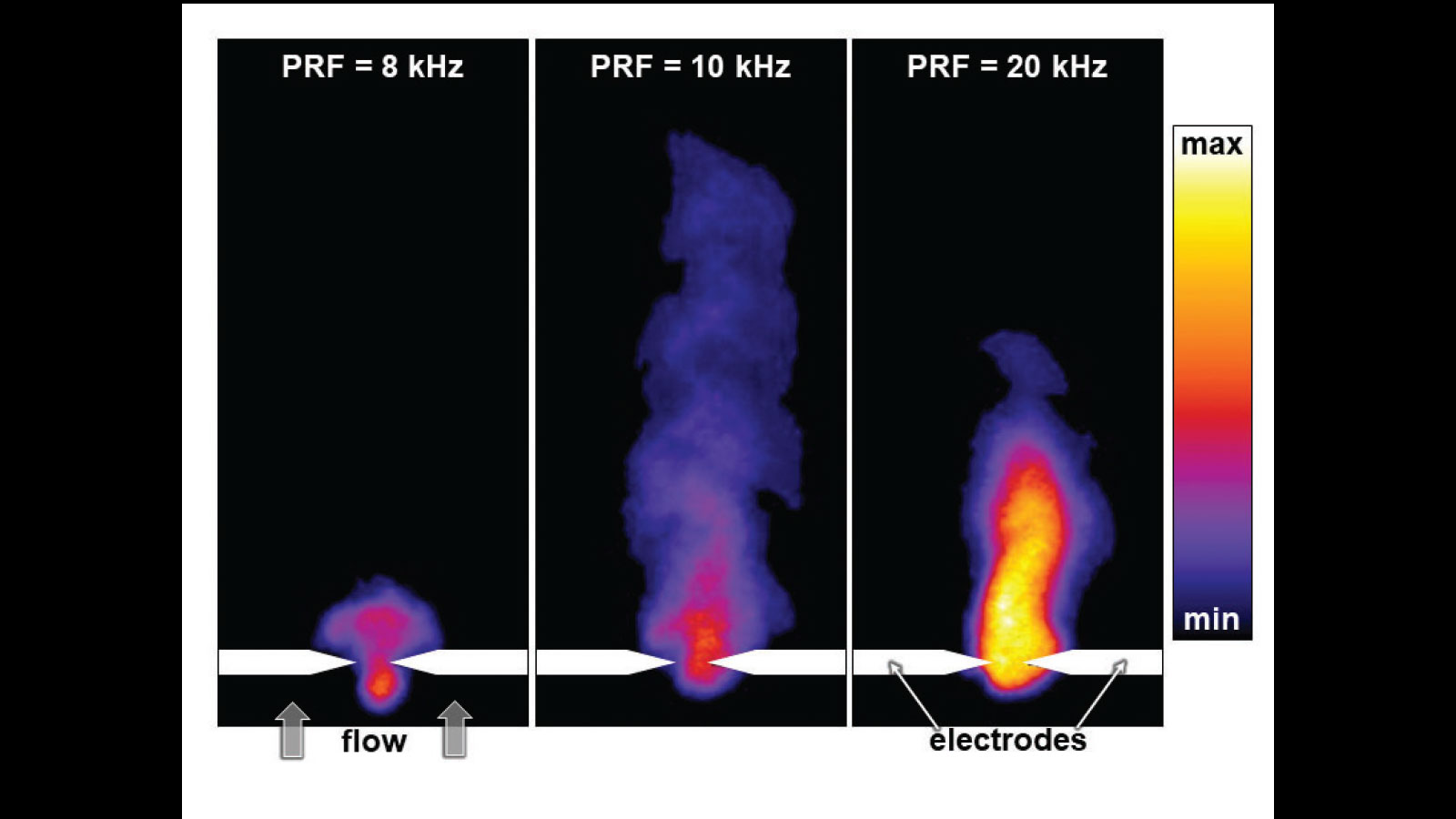Stay Up to Date
Submit your email address to receive the latest industry and Aerospace America news.
The Propellants and Combustion Technical Committee works to advance the knowledge and effective use of propellants and combustion systems for military, civil and commercial aerospace systems.
Multiple milestones were achieved this year that demonstrated the unique advantages of repetitive pulsed discharges for ignition in reacting flows relevant to a variety of engines.
The milestones were achieved through collaboration among the U.S. Air Force Research Laboratory in Ohio, the Technion-Israel Institute of Technology, Oregon State University, Texas A&M University, University of Central Florida and University of Dayton.
In January, infrared imaging thermometry showed that the synergy between pulses at frequencies greater than or equal to 10 kilohertz produced elevated temperature ignition kernels, which explained the higher ignition probabilities and more rapid kernel growth rates observed in previous years’ efforts. Complementing the temperature measurements, 50-kHz planar laser-induced fluorescence measurements, in April, confirmed that sustained elevated concentrations of hydroxyl radicals are present in developing ignition kernels for greater than or equal to10 kHz pulsation rates.
In July, optical emission spectroscopy measurements revealed that pulsation frequencies of 250 kHz nearly doubled the translational temperature over single pulse temperatures. The results thus far have shown that high-frequency repetitive pulsing allows enhanced and optimized ignition in reacting flows.
In a quest to decrease emissions for commercial aircraft engines, a six-month computational effort funded by NASA’s Glenn Research Center in Ohio ended in February after developing the initial design of a novel injection system, called Lean Fully Premixed. This injection method achieves fully premixed combustion with the key advantages of minimizing NOx (nitrogen oxides) and eliminating soot and fuel spray. Preliminary results with numerical simulations are encouraging, and the design must be numerically optimized and experimentally tested. The LFP injection system offers a route toward the application of a premixed combustion mode for significant advancement of aircraft propulsion. Results were published at the ASME Turbo Expo 2019 and the AIAA Propulsion and Energy Forum 2019.
Following the theme of lean combustor operation, an on-going project funded by AFRL studied lean blowout, or LBO, and intrinsically flame stabilization. Transient sequences of a laboratory-scale premixed flame were undertaken and identified the role of the swirling flow inner recirculation zone during the LBO. Premixed simulations were performed to resolve the flame-front thickness at nearly the Kolmogorov scales throughout the domain. The overall dynamics and simulation results favorably compared with experiments.
Shifting to sustainable aviation fuels, or SAF, work this year under the multiagency National Jet Fuels Combustion Program, a European collaborative program, and a Navy program developed a two-tiered prescreening methodology to predict and measure properties and, in turn, predict the effect of these properties on critical high volume and cost approval tests. ASTM D4054, the process for SAF approval is complex. The proposed prescreening methodologies do not replace the established ASTM process, but can provide a producer with increased confidence of approval and perhaps accelerate the process. The United Nations International Civil Aviation Organization identifies the market adoption of SAFs as the major opportunity to mitigate the environmental impact of aviation transportation; hence, there is market interest and importance to these new developments.
In support of the SAF prescreening proposal, researchers at the University of Dayton, Purdue University and the German Aerospace Center, DLR, in September developed software to read gas chromatograph results to predict critical fuel properties while requiring only microliters of volume, and researchers at Stanford University were planning to apply midinfrared absorption capabilities to predict properties; manuscripts have been submitted for publication describing the new process. A Commercial Aviation Alternative Fuels Initiative technical guidance document (www.caafi.org) posted in September summarized some of these results. Collectively, these prescreening results and methodologies significantly lower the barrier for early SAF evaluations and offer the opportunity to expedite the approval process of novel SAFs.
Contributors: Campbell Carter, Med Colket, Stephen Hammack, Ron Hanson, Joshua Heyne, Gozdem Kilaz, Joseph Lefkowitz, Patrick LeClercq, Paul Palies and Bastian Rauch
Related Posts
Stay Up to Date
Submit your email address to receive the latest industry and Aerospace America news.




